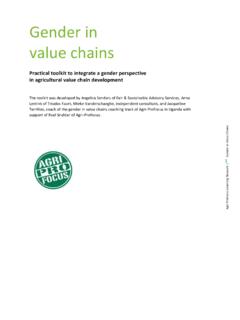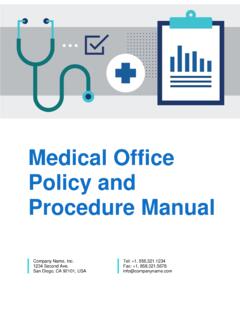Transcription of Manual on Gender Analysis Tools - AgriProFocus
1 Manual on Gender Analysis Tools Biruktayet Assefa and Nina de Roo, 2015 ii The CASCAPE project is designed to assist the activities deployed under the Agricultural Growth Programme (AGP) by further strengthening the capacity of AGP stakeholders in identifying, documenting and disseminating best practices in agricultural production. CASCAPE is jointly executed by Ethiopian researchers from Jimma University, Haramaya University, Bahir Dar University, Hawassa University, Mekelle University, Addis Ababa University and Dutch researchers from Wageningen University and Research Centre.
2 In each site researchers from the universities and from the RARIs from different disciplines work on the CASCAPE project. The CASCAPE project is financed by the Dutch Ministry of Foreign Affairs through the Embassy of the Kingdom of The Netherlands. For further information and requests for copies please send an E-mail to iii Contents Introduction .. 1 1. Basic Gender terms and definitions .. 3 2. Gender Analysis Tools /frameworks .. 8 Harvard Gender Analysis framework .. 8 Activity profile .. 8 Daily activity clock (24 hour daily calendar).
3 17 Seasonal calendar .. 22 Access and control profile .. 23 Gender Analysis Matrix (GAM) .. 25 Decision-making on 27 3. When to conduct Gender Analysis ? .. 28 4. What to do with the results of Gender Analysis ? .. 30 5. References .. 31 6. Annex 1: Case studies .. 32 Annex 2: Example of an evaluation form .. 36 Annex 3: Example of a questionnaire used for conducting Gender Analysis .. 37 iv List of Tables Table 1: Practical and Strategic Gender needs .. 6 Table 2: Activity profile .. 9 Table 3: Example of Gender activity Analysis for maize crop.
4 10 Table 4: Daily activity clock .. 17 Table 5: Seasonal calendar .. 22 Table 6: Access and Control profile .. 24 Table 7: Gender Analysis Matrix (GAM) .. 26 Table 8: Check list: Decision-making on benefits .. 27 List of figures Figure 1: Example of graphic interpretation of activity profile .. 16 Figure 2: Example of women s daily activity clock in Mekelle during the peak season .. 21 v Acronyms and Abbreviations CASCAPE Capacity Building for Scaling-up of Evidence-based Best Practices in Agricultural Production in Ethiopia FAO Food and Agriculture Organization (United Nations) FGDs Focus Group Discussions GA Gender Analysis GAM Gender Analysis Matrix HH Household PCM Project Cycle Management 1 Introduction Agriculture is central to the livelihoods of the rural poor.
5 Women, especially in many developing countries, comprise the largest percentage of the workforce in the agricultural sector. They play a predominant role and have an important economic contribution to agricultural production. Yet these roles are often unrecognised. Failure to recognise the roles, differences, and inequalities has an implication on the effectiveness of the agricultural development. Agricultural intervention that aims to support beneficiaries has Gender implications it will impact men and women differently.
6 Thus, closing the Gender gap in agriculture is important so as to ensure productivity and food security. Non-differentiation of beneficiaries has often resulted in the invisibility of women farmers. Gender Analysis is one of the analytical processes that help visualise and identify differences and similarities between men and women farmers, thus providing the basis for effective and Gender sensitive project intervention. The Gender Analysis Tools not only allow men and women farmers to describe their daily activity but also identify the different constraints that they face in agricultural production, processing and marketing.
7 Besides, the Tools assist any project in identifying men s and women s roles & responsibilities and their implications for project strategies. This ultimately gives direction to the designing of possible mechanisms to bridge the Gender gaps. Constraints such as lack of conceptual clarity as well as practical applicability of Gender issues are hindering factors to bring significant changes. One of the approaches in addressing the issue is application of relevant Tools and methods. Manuals could be considered as a practical way of incorporating and interpreting Gender issues in agriculture.
8 In light of this, CASCAPE prepared this Manual with the purpose of improving the knowledge and skills of those who work on Gender in CASCAPE and related projects and provide them with basic Gender Analysis Tools so that they create Gender -sensitive interventions. In the first section of this Manual an overview of definitions related to Gender are provided. The main sections exclusively focus on Gender Analysis frameworks and their 2 respective Tools that are essential for designing and implementing Gender -sensitive activities in agricultural development projects.
9 It gives emphasis on the following issues: which Tools to use, how and when to use, its interpretation, and what to do with the result. For this purpose, icons are added, indicating some tips on how to conduct each tool . In general, the Manual will assist to understand how important it is to consider Gender in project activities and, how to go about it. We trust that those who work on Gender in CASCAPE and related projects will find it useful and applicable in their day-to-day work. 3 1. Basic Gender terms and definitions It is important to spend enough time discussing the terms and definitions in order for the participants to fully understand their meaning.
10 Gender It describes the socially constructed roles and responsibilities of women and men, and includes expectations held about characteristics, and likely behaviours of both men and women; the roles that we learn to fill from childhood onward. In short, Gender refers not to women or men per se, but to the relations between them, both perceptual and material. Sex It refers to the genetic and physiological characteristics and traits that indicate whether one is male or female. Gender equality It is the result of the absence of discrimination on the basis of a person s sex in opportunities and the allocation of resources or benefits or in access to services.








